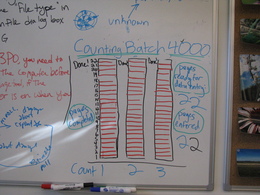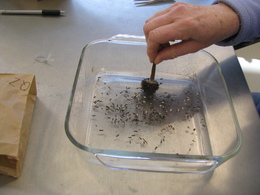As you can see in this lovely motivational diagram, we finally finished counting last year’s achenes from the 1999 experimental plot.
The next step for this batch will be to collect a random sample of achenes from each flower head to estimate pollination rates. We can tell whether an achene is “full” (contains an embryo) or “empty” (does not contain an embryo) based on its weight. We can estimate pollination rates based on the ratio of full and empty achenes. However, there are some achenes whose weight does not give us any information about pollination. Some are so small they never produce an embryo, some are damaged by insects, some are damaged during removal from the flower head, etc. If we weighed these, they would show up as “empty”, even though they may have been pollinated. Therefore. when we select a random achenes for weighing, we have to differentiate between those that are informative about the pollination environment (full or empty) and those that are not informative (small, sterile, damaged, etc.).
For this batch, we are starting a new randomization protocol that assigns achenes to categories of “informative” (possibly full or definitely empty) and “uninformative” (sterile, undersized, damaged). Both are part of the random sample, but only the informative achenes are weighed. It’s a subtle distinction from what we were doing before, but it will be important for our results.
Now that we have reached our goal in counting, we have started processing the heads we harvested in 2012. Today volunteers Katharine and Sam are trying out a new protocol for removing the achenes from Echinacea heads. Previously, we through away any dust left over from removing achenes. This time, we are saving the dust in separate envelopes. That way, we will be able to figure out whether the dust we throw away contains fragments of achenes. Also, we will be able to compare scans with and without the extra dust to see whether removing dust makes a difference in the accuracy of our count data.



Leave a Reply